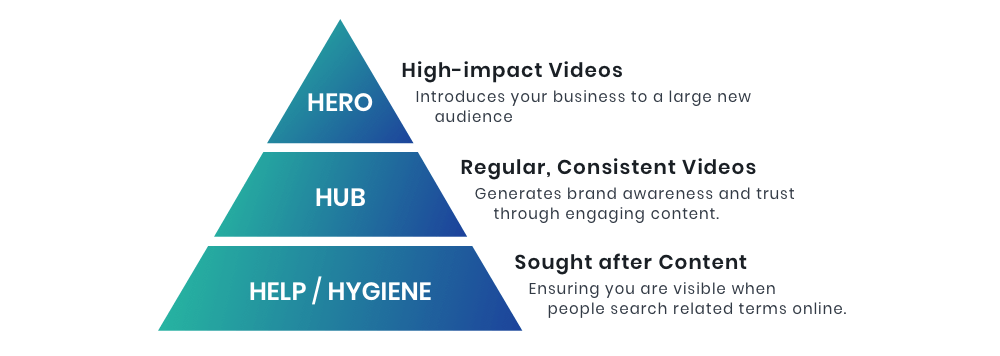Today, video is widely regarded as the most effective form of communication when it comes to digital content. And hey, we’re Shootsta – we love video!
However, in the age of #fakenews – and seemingly impressive internet statistics like ‘our brains process visuals 60,000x times faster than text’ being trundled out by media companies from Forbes, to Business 2 Community, to Fast Company (only to be debunked) – we felt it timely to put our money where our mouth is, and answer the question: how? How is video so successful?
This article aims to examine just that, with a focus on the psychology of video and its effect on emotion.
So read on for answers, you guessed it, brought to you by science…

Video and emotion
We begin by looking at the link between online videos and human emotions. While video is generally assumed and accepted as effective for business and content for brands, there’s surprisingly little information on the mechanics of why (or how); a stark contrast to the creative industries of film or advertising. So… Has the link between video and evoking emotions actually been established?

What the research says
Basically, yes. Not only are moving images like film clips a supported stimulus for emotional elicitation experiments in psychology (and have been for the past 50+ years) – but recent meta-analyses to compare prior research on visual vs. other types of stimuli have hailed video as a successful, if not the most successful way of stimulating emotional responses e.g. in ‘Effectiveness of internet-based affect induction procedures: A systematic review and meta-analysis’ (Ferrer, Grenen, & Taber, 2015; also Fernández-Aguilar et al, 2019 for the effectiveness of film, and Siedlecka & Denson, 2018 for the effectiveness of visuals).
How does it work
The key might just be in the word ‘emotions’. In their chapter, ‘Emotion Elicitation Using Films’, Rottenberg, Ray, and Gross (2007) define emotions as “a transient but coordinated set of responses that occur when an individual faces a situation (real or imagined) that is relevant to salient personal goals”. Thinking back to the research, videos that stimulate our emotions may do so because they draw on concerns about ourselves, our lives and our “salient personal goals” in some way. Conversely, the notion of empathy, “the ability to understand and share the feelings of another” i.e. identifying with someone else’s concerns or goals, may also be a factor. This goes a little way to explaining some of the simple emotions like happiness, sadness, even anger, surprise and fear, that we may feel in consuming video content.
But how does it work? One theory tells of ‘mirror neurons’ in the brain, “that fire whenever an animal performs an action, such as stretching out its arm or reaching toward a target, and also whenever the animal watches another performing the same action”. The idea being, if you’re watching an actor cry in a video, you’re more likely to respond in kind as your brain is primed for this behaviour (emotion-wise, this appears to be an evolutionary thing). The premise is backed by Jeffrey Zacks, professor of psychology at Washington University in St. Louis and author of the book, ‘Flicker: Your Brain on Movies’ – who refers to this phenomenon as the ‘mirror rule’. Furthermore, these reflective responses can be augmented by videographers, using cinematography techniques like close-ups to connect audiences with actors’ facial expressions (more on that here).
”Creating common ground with an audience is like clearing a pathway from their heart to yours… By identifying and articulating shared experiences and goals, you build a path of trust so strong that they feel safe crossing to your side.”
Nancy DuarteResonate’
Emotion in filmmaking
Following on from cinematography and our earlier note on the exploration of emotion in fields like cognitive film theory, there also exists the ‘film school’ answer to emotion – which incorporates audio (music, dialogue, sound effects etc.) and visual (acting talent, colour, light etc.) elements of video storytelling. These include techniques like using warm vs. cool hues and colour psychology to depict happiness or sadness, as well as aspects like key, contrast, and light direction, for eliciting mood or tone.
The subject of emotion and mood is discussed in ‘Art Moods and Human Moods in Narrative Cinema’ (Plantinga, 2012). Here, Plantinga looks at mood – defined as more abstract than causal emotions – and its relationship to a film’s emotional impact. He supports the emotion and empathy lines of reasoning we introduced, stating, “films elicit emotions when they lead spectators to construe narrative events in relation to their concerns”, but also goes on to specify how crafting a mood that orients emotional states can actually be done. “For the filmmaker to represent and express affectively charged ‘qualities’ through form and content … the film noir may set the scene in the city late at night, the empty streets deserted and the rain falling, a few figures huddled in isolated doorways – all suggestive of darkness, wetness, coldness, and loneliness. On the soundtrack are the strains of melancholy music, together with the faint sounds of a quarreling couple in some nearby apartment” (anyone who’s watched the movie ‘Chinatown’ – or more recently, Marvel x Netflix’s ‘Jessica Jones’ – will be inherently familiar).
Swinging back to the psychology side, in 2014, the Academy of Motion Picture Arts and Sciences held a conference, ‘Movies in Your Brain: The Science of Cinematic Perception’, where authorities like Darren Aronofsky (director of ‘Black Swan’) and Talma Hendler (neuroscientist at Tel Aviv University) discussed fMRI brain scans and their results for the experience of emotions and empathy in films like ‘Black Swan’. Hendler’s research has led her to posit two forms of empathy: “one type she calls mental empathy, which requires you to mentally step outside yourself and think about what another person is thinking or experiencing. The other type she calls embodied empathy; this is the more visceral in-the-moment empathy you might feel when you see someone get punched in the guts”. In Aronofsky’s film, both types of empathy were recorded in viewers according to associated brain function areas. It’s a fascinating area of research, and one that hearkens back to our earlier assertion of empathy being key to video (when sentient beings are starring, at least).
Emotion in advertising
Now… Why is all this important? The answer: because emotion (and empathy, in how we identify with / relate to people and brands in videos) is the consumer gatekeeper for everything from brand sentiment, all the way through to purchase intent in business. To quote the American Association of Advertising Agencies (AAAA) and the Advertising Research Foundation (ARF)’s 2007 white paper, ‘On the Road to a New Effectiveness Model: Measuring Emotional Responses to Television Advertising’, “to determine how engaging advertising messages are, we would start by testing for and learning first about emotion, the reaction that impacts any further processing of the brand idea and motivation to purchase and/or use the brand”.
Their study has implications for the traditional ‘think-feel-do’ model of advertising, and is the conceptual area picked up by Simon Sinek in his seminal 2010 TED Talk, ‘How great leaders inspire action’ (a.k.a. the ‘start with why’ video). In it, he argues that the ‘why’ level of his ‘golden circle’ theory is informed by our limbic system’s brain structures: “our limbic brains are responsible for all of our feelings, like trust and loyalty. It’s also responsible for all human behaviour, all decision-making, and it has no capacity for language.” The point he makes is that decisions are initially shaped by emotions, then rationalised with logic – the results of which are critical, according to the AAAA and ARF: “advertising messages that successfully generate a strong emotional reaction are stronger on more than one of the traditional measures (recall, persuasion, liking) than those that don’t … Emotional reactions not only come first, they facilitate memory and influence actions”.
The conclusion: emotion drives more behaviour than perhaps we previously thought, which is a valuable learning when it comes to digital business content and strategy.
What does this mean for video?
Bundling the research into video as a medium and emotion, plus insights from the film and advertising industries with regards to video-based creative, it’s possible to suggest a few key takeaways:
1. Psychological research into emotion science is of the consensus that video is a successful tactic for stimulating emotions.
2. Empathy appears to be a key driver for this, and content creators can help prime these responses using mood / tone-based cinematic techniques, as well as providing for identification with characters (via story).
3. Consumer behaviour may not be as linear as we thought, with emotion not only capable of but likely driving the decision-making process, including buying choices. As a result, strong, positive brand or product/service associations will be beneficial to business – and can be generated with video.
TL;DR: Video is extremely effective at evoking emotions.


